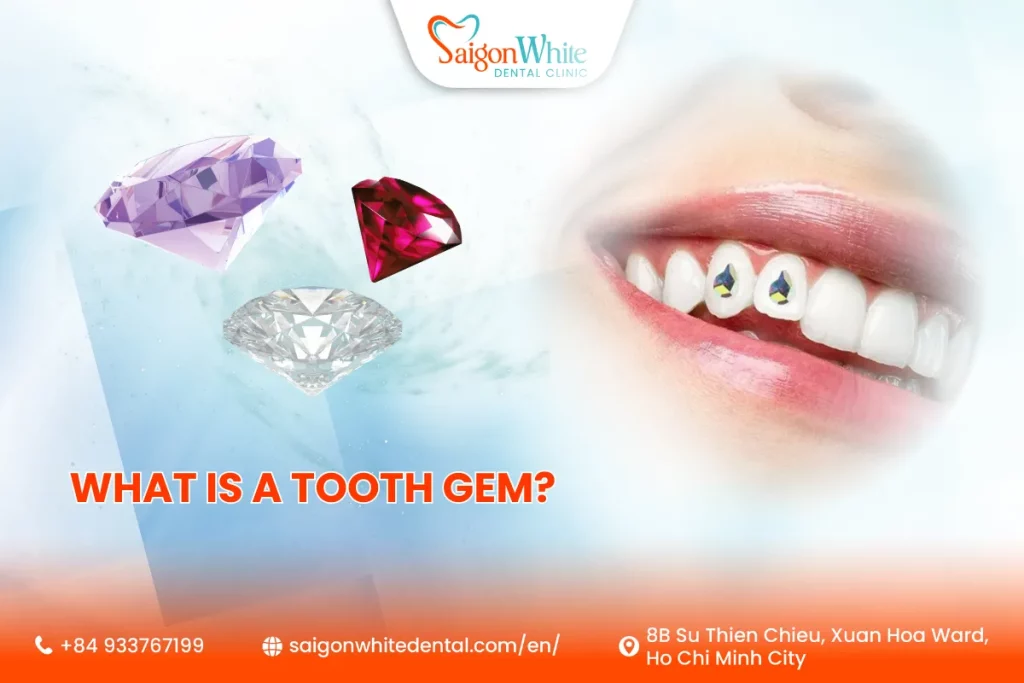In recent years, cosmetic dentistry has evolved far beyond traditional treatments like whitening and veneers. One of the most eye-catching trends taking social media by storm is the tooth gem. From celebrities to everyday fashion enthusiasts, more people are choosing this sparkling accessory to enhance their smiles. But what exactly is a tooth gem? Why are they becoming so popular? And what types are available?
This article will answer those questions by breaking down the definition, benefits, and types of tooth gems. Whether you are curious about trying one yourself or simply want to understand the trend, this guide will provide a clear and comprehensive overview.

What Is a Tooth Gem?
A tooth gem is a small decorative jewel that is applied to the surface of a tooth for aesthetic purposes. Unlike crowns, veneers, or grills, tooth gems are non-invasive and temporary. They are bonded to the enamel with a safe dental adhesive, similar to the one used for orthodontic brackets.
Key characteristics include:
- No drilling or permanent alteration: The enamel remains intact.
- Variety of materials: Crystals, gold, diamonds, or semi-precious stones.
- Customizable: You can choose single gems, patterns, or shapes.
- Temporary: They last anywhere from a few months to two years, depending on care.
This makes tooth gems a playful and stylish way to enhance a smile without committing to a permanent dental procedure.
History and Origin of Tooth Gems
While tooth gems may seem like a modern fashion trend, the practice of decorating teeth has a long history.
- Ancient roots: The Mayans and other ancient civilizations decorated teeth with jade, turquoise, and other stones as a sign of wealth and status.
- Cultural revival: In the 1980s and 1990s, tooth jewelry gained attention through hip-hop culture, with rappers and artists sporting gold caps and grills.
- 2000s comeback: The trend resurfaced in the early 2000s with celebrities experimenting with crystals and studs.
- Modern popularity: Today, thanks to Instagram, TikTok, and celebrity endorsements from stars like Hailey Bieber and Lil Wayne, tooth gems are back in the spotlight as a mainstream fashion accessory.
This evolution shows how tooth decoration has transformed from cultural expression to high fashion.
How Tooth Gems Are Applied
The process of applying a tooth gem is quick, non-invasive, and completely painless when done by a dental professional. Unlike crowns or veneers, it does not involve drilling, reshaping, or permanent alteration of the tooth. Here’s a step-by-step breakdown:
1. Initial Consultation
- The dentist examines your teeth and gums to ensure they are healthy.
- If there are cavities, gum disease, or enamel weakness, the procedure may be postponed.
- You choose the gem type, size, and design (e.g., Swarovski crystal, gold stud, or diamond).
2. Tooth Cleaning
- The selected tooth is professionally cleaned and polished.
- This removes plaque, tartar, or stains, which ensures the adhesive bonds properly.
3. Isolation and Drying
- The dentist uses cotton rolls or a cheek retractor to isolate the tooth.
- A completely dry surface is crucial for strong bonding.
4. Etching the Enamel
- A gentle etching gel (mild acidic solution) is applied for a few seconds.
- This roughens the enamel microscopically, creating a stronger surface for the adhesive.
- The etching gel is then rinsed off, and the tooth is dried again.
5. Bonding Agent Application
- A thin layer of dental bonding resin (the same material used for braces brackets) is applied.
- This acts as the “glue” that holds the gem securely in place.
6. Gem Placement
- Using a special applicator tool, the dentist carefully positions the gem on the tooth.
- Precision is key—once set, the gem must be perfectly aligned for both comfort and aesthetics.
7. Light Curing
- A blue LED dental curing light is used for 20–60 seconds.
- The adhesive hardens instantly, locking the gem onto the enamel.
8. Final Polishing and Check
You’ll be asked to bite down and move your lips/tongue to make sure the gem feels comfortable.
The dentist checks the gem’s stability and ensures there are no rough edges.
Benefits of Tooth Gems
Tooth gems have gained popularity because they combine style, self-expression, and convenience. Unlike many cosmetic dental treatments, they are quick, affordable, and non-permanent, making them an attractive choice for people who want to enhance their smile. Let’s break down the main benefits:
1. Aesthetic Enhancement
- Tooth gems add a unique sparkle that immediately draws attention to your smile.
- They can be subtle (a small, clear crystal) or bold (multiple gems or gold designs), allowing you to match your look to your personality.
- They act like jewelry for your teeth—just as earrings or necklaces complete an outfit.
2. Non-Invasive and Safe
- The procedure does not require drilling, reshaping, or anesthesia.
- Enamel is left intact, and the adhesive used is dental-grade and reversible.
- Compared to veneers or crowns, which permanently alter your teeth, gems are much gentler.
3. Temporary and Reversible
- You can enjoy the look without committing to life.
- If you change your style or get bored, a dentist can remove the gem quickly and polish your tooth back to normal.
- Perfect for people who like experimenting with fashion trends.
4. Affordable Cosmetic Option
- Cosmetic dentistry can be costly, but tooth gems are relatively inexpensive.
- Crystal gems may cost as little as $50–100, while premium options like diamonds are still far cheaper than veneers.
- This makes them accessible to students, young professionals, and fashion lovers.
5. Quick and Painless Procedure
- The entire process usually takes 10–20 minutes.
- No recovery time is required—you can eat, smile, and go about your day right after.
- Many people get tooth gems during a routine dental visit.
6. Customizable and Expressive
- With options ranging from Swarovski crystals to shaped designs like hearts or stars, gems are highly customizable.
- They allow you to express individuality, creativity, and personal style.
- You can even match gems to outfits, events, or brand identity if you’re a public figure or influencer.
7. Confidence Booster
- A sparkling smile naturally boosts confidence.
- Many people report feeling more stylish, outgoing, and camera-ready with a gem.
- They’re particularly popular for social media influencers, performers, and anyone who loves standing out.
Types of Tooth Gems
Tooth gems come in many forms. You can choose based on material, design, or duration.
1. By Material
- Swarovski Crystals: The most common option. Affordable, sparkly, and available in multiple colors.
- Gold or Silver Studs: A classy metallic look that adds subtle luxury.
- Diamonds and Precious Stones: For those seeking premium, long-lasting brilliance.
- Semi-Precious Stones: Amethyst, sapphire, or other unique gems for personalization.
2. By Design
- Single Gem: A minimalist style that adds a touch of sparkle.
- Multiple Gems: Arranged in patterns or along the tooth line for more dramatic effect.
- Shaped Designs: Hearts, stars, butterflies, or initials.
- Custom Designs: Personalized to match your personality or brand identity.
3. By Duration
- Temporary: Lasting from a few weeks to a couple of months, depending on the adhesive.
- Semi-Permanent: Professionally applied gems lasting 6 months to 2 years.
This flexibility allows individuals to choose the style that best suits their personality and budget.
Safety, Risks, and Who Should Avoid Tooth Gems
Safety
When applied by a dental professional, tooth gems are safe. They don’t require drilling, and the enamel remains intact.
Risks
- Plaque accumulation: Food particles may get trapped around the gem.
- Enamel damage: If removed improperly, enamel may chip.
- DIY dangers: Using non-dental adhesives may lead to infection or permanent damage.
Who Should Avoid
- Children or teens whose teeth are still developing.
- People with untreated cavities or gum disease.
- Those with very weak enamel or hypersensitivity.
Maintenance and Care
To keep your tooth gem shining and your teeth healthy:
- Brush and floss daily: Pay extra attention to the gums.
- Avoid sticky and hard foods: Caramel, gum, and hard candies can loosen the gem.
- Don’t pick at the gem: Attempting to remove it yourself may harm enamel.
- Visit your dentist regularly: Ensure the gem isn’t causing hidden damage.
With proper care, your tooth gem can last its full lifespan while keeping your smile healthy.
Alternatives to Tooth Gems
If you want to brighten your smile without a gem, here are alternatives:
- Tooth-colored bonding: A shiny, subtle enhancement.
- Porcelain veneers: Long-term aesthetic solution.
- Professional whitening: A natural, brighter look.
- Temporary stickers or glitter: A fun option for special occasions without commitment.

 Telegram
Telegram